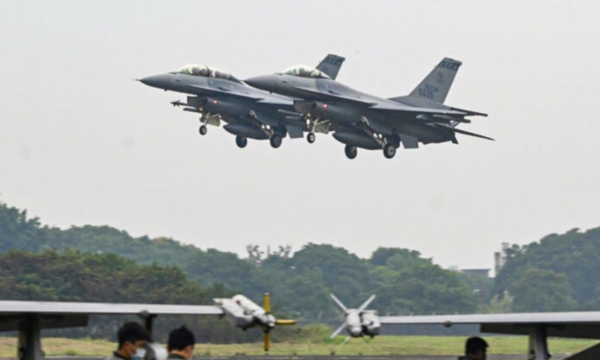

 字體:小 中 大
字體:小 中 大 |
|
|
|
| 2022/08/22 04:25:34瀏覽409|回應0|推薦6 | |
|
小而美的台灣面臨中共經常性威脅
搭第四次工業革命順風車充實國防實力
採用美國DARPA模式全心發展AI技術強化國防與經濟利基
作者好像講的蠻中肯的,好像應該走這樣的路;不然,難道要退回當摩登原始人嗎?但,好像看來又是一場廢話,因為全世界每個國家都在往這條路發展?
以下:
面對中共解放軍經常性的武力威脅,台灣的利基點在搭著第四次工業革命(4IR)的順風車,深耕AI技術。台灣有很多優秀平價人才,即便如此,面對趨勢所趨,人力庫仍不夠。當務之急便是及時培養相關人才,至少需要再補一倍的人。
幾個重點技術,像是:
人工智慧 (AI)、
機器學習、
量子計算、
自動化機器人技術
網路的東西。
這些技術有助台灣精準快速提升戰地知識做出致命回擊。
#台灣發展AI技術的優勢基礎
台灣擁有世界上最強、最全面資訊技術的環境,特別在半導體製造,以及積體電路的設計。擁有大量優秀平價的工程人才。
即便這樣,為迎接第四次工業革命,人力還是不夠。特別是AI關鍵技術。
台灣在4IR的主題下開展幾個方案
(✓)亞洲矽谷發展計劃,將台灣與全球高科技研發中心聯結起來洞燭機先。同時也希望強化在 IT資訊領域硬體的部分,保持與強化其領先地位。
(✓)2030年前生產出1奈米以下的晶片
台灣是全球半導體產業的重鎮,在全球晶圓生產和晶片封測排名第一,矽晶片產量排名第二。
特別是,像台積電是全球最大晶片代工廠,在台灣擁有四家超級工廠,可生產小到5奈米的晶片。
在半導體人才的前瞻計劃下,整合台灣的國際戰略地位,並進一步擴大在IT產業的優勢。
特別是,台灣希望強化晶圓生產的競爭優勢,#2030年前能生產出1奈米以下的晶片。並強化島內北中南科學園區的聯繫,讓國家半導體產業統合集中保持領先位置。
軍事的利基在AI
最重要的是,軍事的未來在AI人工智慧行動方案。台灣在半導體、資訊、通訊技術與微晶片製造的優勢被視為是發展AI的超級基礎。
行政院投入380億新台幣發展數位專案,包括:擴大培養相關人才,擴大鞏固在半導體領域的領先地位,放寬法規促進創新技術的發展,利用人工智能改變台灣的產業。
其中一項是共享AI人工智能與大數據雲端計算平台,於 2019年5月推出,後擴展到商業用途,新創公司能進入並取用內容,應用於他們的AI產品開發。
也呼籲一些大型跨國公司能為國家人工智能發展做出貢獻。谷歌、IBM 和微軟等全球企業紛紛表達它們在台灣設立AI研發中心的興趣,與政府機關與學術機構密切合作,培養僱用台灣一流人才。
地方政府、大學與學術機構也積極參與人工智能的研究。
走DARPA模式
整體而言,台灣打算走DARPA模式(美國國防高級研究計劃局) ,採用支援國家AI基礎建設的研究項目與模組,找到AI最利多的領域.
第四次工業革命與國安問題的部分
會著重在網絡安全的部分,推出行動方案。網路安全已成為國安很大顧慮,網路安全的產品與服務會持續成長。台灣政府把網路安全作為國防工業計畫的一部分。
像台灣這樣小而美的國家,4IR(第四次工業革命)有助在打造一連串機會。機會的背後是挑戰,台灣在國防突破上尚待時間,在時間上又非常緊迫。
順著第四次工業革命之流,全心發展AI科技,可能是台灣回應中國的最佳機會。
大紀元特約作者
其言論不代表大紀元立場
https://www.theepochtimes.com/taiwan-piggybacking-on-the-4th-industrial-revolution-for-new-military-prowess_4668871.html?utm_medium=Social&utm_source=telegram
The existential threat to Taiwan is self-apparent, or at least it should be to anyone who has watched how, in recent weeks, China has bracketed the island with missile tests, military exercises, and increasingly hostile incursions by the PLA Air Force. Equally self-evident is Taiwan’s need to beef up its defenses.
Besides the usual requirements for better kinetic weapons—items like modern fighter jets, longer-range missiles, submarines, and the like—Taipei needs to find new force multipliers, capabilities that will increase Taiwan’s chances of defending itself and deter a possible invasion.
Increasingly, these capabilities are things like artificial intelligence (AI), machine learning, quantum computing, automation and robotics, and the “internet of things.” These technologies will help Taiwan react faster, with vastly improved “battlespace knowledge” and with greater accuracy and lethality.
These technologies are embedded in what we call the “fourth industrial revolution,” or 4IR. The 4IR promises to create a new set of opportunities and challenges regarding how a country like Taiwan can leverage such technologies for military modernization.
More than most countries, Taiwan has an inherent ability to piggyback on huge, 4IR-related leaps in its commercial sector. The island is home to one of the world’s strongest and most comprehensive information technologies (IT) ecosystems, especially in semiconductor manufacturing and integrated circuitry design. It also possesses a high-quality workforce, particularly a large pool of skillful but inexpensive engineering talent.
At the same time, the supply of domestic talent is still deemed insufficient to meet rising demand, especially regarding such 4IR technologies as AI.
Consequently, Taiwan has implemented several technonationalist development programs centering on 4IR technologies. One of these is the “Asia Silicon Valley” Development Plan, intended to connect Taiwan with high-tech R&D communities worldwide and seize opportunities in next-generation industries.
In conjunction, Taiwan wants to retain and strengthen its considerable lead when it comes to the hardware side of its IT sector.
Taiwan is a global heavyweight in the semiconductor industry, ranked first in global wafer production and chip packaging and testing, and second in silicon wafer output.
In particular, Taiwan specializes in “pure play” semiconductor foundries that manufacture chips according to spec, such as the Taiwan Semiconductor Manufacturing Company (TSMC). TSMC is the world’s largest chip foundry, with four GigaFabs in Taiwan, and it can manufacture chips with a process node as small as 5 nanometers.
Under Taipei’s “Advancing Forward-Looking Semiconductor Talent and R&D” plan, Taipei plans to consolidate Taiwan’s international strategic position and to further expand upon its existing advantages in the IT market.
In particular, Taiwan plans to increase its competitive advantage in wafer production by progressing toward the goal of being able to produce a semiconductor chip with a process node of one nanometer or less by 2030. The government also wants to strengthen links and interconnections among the island’s science parks in Hsinchu and central and southern Taiwan, ensuring that the national semiconductor industry cluster remains a technology leader.
Most important for future military capabilities is “Taiwan AI Action Plan.” Taiwan’s strengths in the fields of semiconductors, information and communication technologies, and microchip manufacturing are viewed as a superlative foundation upon which to build and advance national expertise in artificial intelligence. As a result, the Taiwan government is pouring considerable resources into developing AI and related technologies as part of Taiwan President Tsai Ing-wen’s push to transform Taiwan’s economy for the new digital age.
Multiple government ministries have introduced sweeping, multi-million-dollar AI-focused schemes, which involve the participation of industry, academia, and both publicly and privately funded research institutions.
The Executive Yuan’s “Taiwan AI Action Plan” was launched in January 2018 with a budget of NT$38 billion (about $1.2 billion). One of the plan’s main goals is to enlarge Taiwan’s existing pool of AI engineering talent. In addition, it also sets out to expand and capitalize on Taiwan’s world-leading position in the semiconductor industry, remold Taiwan into an industrial hub, liberalize regulations to enable the development of innovative technologies, and use AI to transform industry in Taiwan.
One such project is a shared-use AI and Big Data cloud-computing platform, powered by the Taiwania 2 supercomputer at the National Center for High-Performance Computing (NCHC). Launched in May 2019 and later expanded for commercial use, this platform—called the Taiwan Computing Cloud (TWCC)—has been accessed by several start-ups to develop their AI-focused products and solutions.
Taipei has also called on industry—particularly large multinational tech firms—to contribute to national AI development. Global players such as Google, IBM, and Microsoft have already established or expressed their intentions to set up AI R&D centers or programs in Taiwan. These facilities will work closely with government and local universities to train and employ Taiwan’s top-tier engineering talent.
Local government, universities, and research institutions are also active in AI research. The Hsinchu County government, for example, plans to open a 126,000-square-meter AI technology incubator near one of Taiwan’s major all-purpose high-tech zones and two top universities. In particular, Taiwan plans to double the number of IT specialists, particularly expanding into AI.
Overall, Taiwan aims to adopt a 4IR R&D model much like the U.S. Defense Advanced Research Projects Agency (DARPA), focusing on the adoption of research projects and models in support of the development of a national AI infrastructure and to discover fruitful areas for AI development.
There is an explicit national security aspect to Taiwan’s 4IR-related technology innovation plans. Under its “5+2 Innovative Industries Plan,” a “national security” initiative is focused on developing and implementing cybersecurity action plans. As cybersecurity risks have become a major concern for national defense, the demand for cybersecurity products and services will continue to grow. The Taiwanese government has integrated cybersecurity into this strategic industrial development plan as a component of national defense.
The 4IR promises to create a new set of opportunities when it comes to how smaller but high-tech countries like Taiwan can leverage such technologies. At the same time, these efforts are not without their challenges, and it will take time for Taiwan to see militarily useful breakthroughs—the time it may not have. However, piggybacking on huge, 4IR-related leaps in the commercial sector—particularly when it comes to AI—is probably the best chance it has to develop asymmetric responses to Chinese aggression.
Richard A. Bitzinger is an independent international security analyst. He was previously a senior fellow with the Military Transformations Program at the S. Rajaratnam School of International Studies (RSIS) in Singapore, and he has held jobs in the U.S. government and at various think tanks. His research focuses on security and defense issues relating to the Asia-Pacific region, including the rise of China as a military power, and military modernization and arms proliferation in the region.
|
|
| ( 時事評論|政治 ) |












